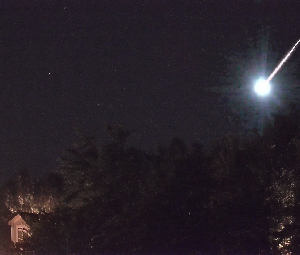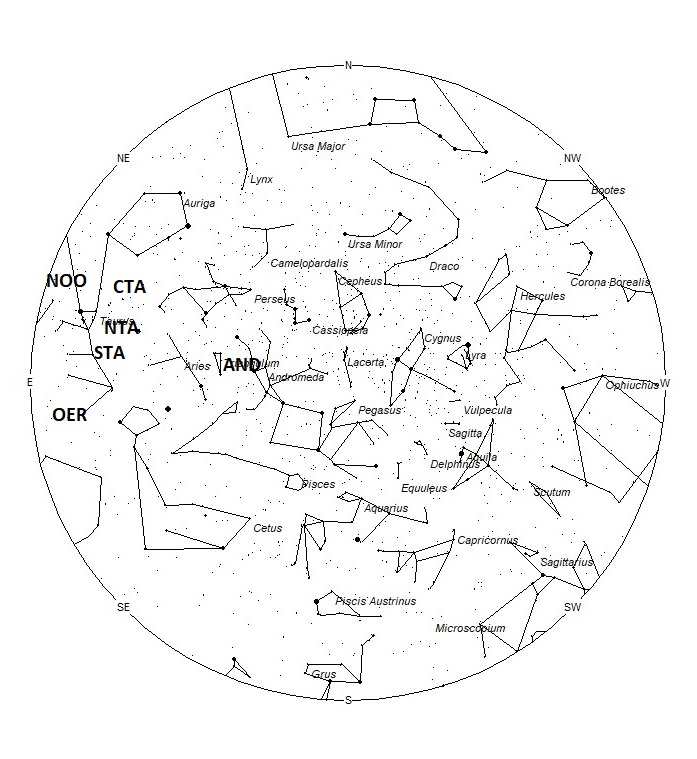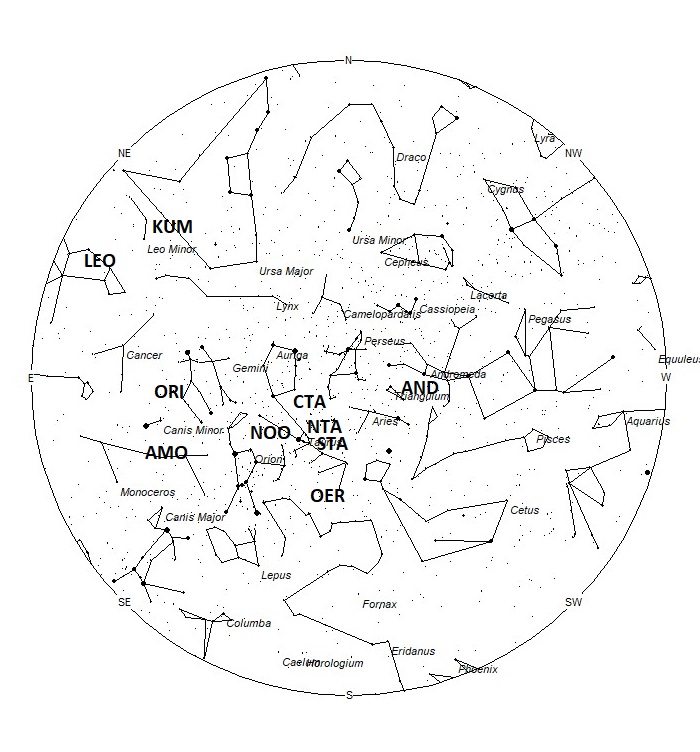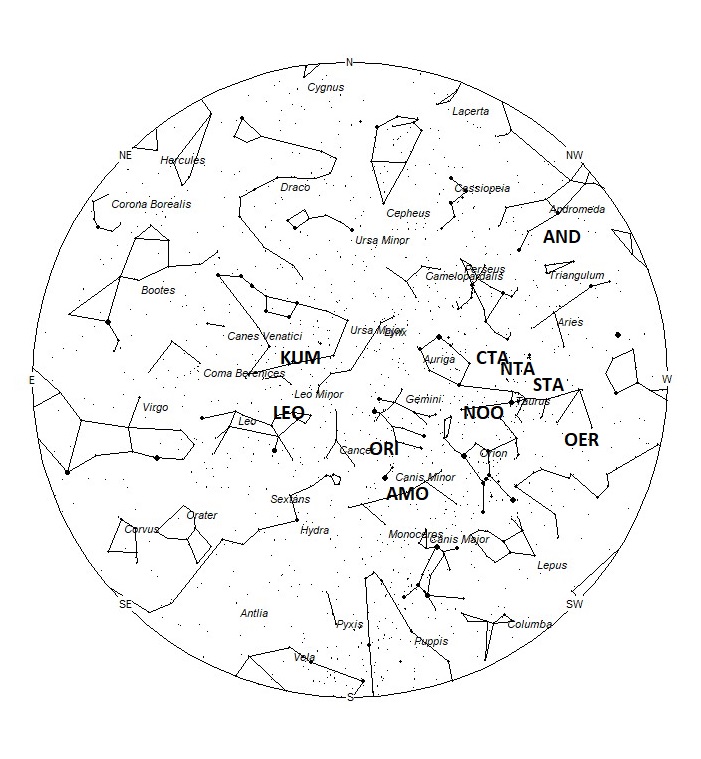 Jordan Ragsdale captured this bright fireball using his AllSky Camera System on June 22, 2023, at 03:09 MDT (9:09 UT) from Eagle, Idaho, USA. ©Jordan Ragsdale
Jordan Ragsdale captured this bright fireball using his AllSky Camera System on June 22, 2023, at 03:09 MDT (9:09 UT) from Eagle, Idaho, USA. ©Jordan RagsdaleDuring this period, the moon reaches its new phase on Monday November 13th. On that morning the moon will be located near the sun and will be invisible at night. As the week progresses, the moon will enter the evening sky but will not interfere with meteor observing as it will be thin and will set shortly after dusk. The estimated total hourly rates for evening observers this weekend should be near 4 as seen from mid-northern latitudes (45N) and 3 as seen from tropical southern locations (25S) For morning observers, the estimated total hourly rates should be near 20 as seen from mid-northern latitudes (45N) and 12 as seen from tropical southern locations (25S). The actual rates seen will also depend on factors such as personal light and motion perception, local weather conditions, alertness, and experience in watching meteor activity. Note that the hourly rates listed below are estimates as viewed from dark sky sites away from urban light sources. Observers viewing from urban areas will see less activity as only the brighter meteors will be visible from such locations.
The radiant (the area of the sky where meteors appear to shoot from) positions and rates listed below are exact for Saturday night/Sunday morning November 11/12. These positions do not change greatly day to day so the listed coordinates may be used during this entire period. Most star atlases (available at science stores and planetariums) will provide maps with grid lines of the celestial coordinates so that you may find out exactly where these positions are located in the sky. I have also included charts of the sky that display the radiant positions for evening, midnight, and morning. The center of each chart is the sky directly overhead at the appropriate hour. These charts are oriented for facing south but can be used for any direction by rotating the charts to the desired direction. A planisphere or computer planetarium program is also useful in showing the sky at any time of night on any date of the year. Activity from each radiant is best seen when it is positioned highest in the sky, either due north or south along the meridian, depending on your latitude. Radiants that rise after midnight will not reach their highest point in the sky until daylight. For these radiants, it is best to view them during the last few hours before dawn. It must be remembered that meteor activity is rarely seen at its radiant position. Rather they shoot outwards from the radiant, so it is best to center your field of view so that the radiant lies toward the edge and not the center. Viewing there will allow you to easily trace the path of each meteor back to the radiant (if it is a shower member) or in another direction if it is sporadic. Meteor activity is not seen from radiants that are located far below the horizon. The positions below are listed in a west to east manner in order of right ascension (celestial longitude). The positions listed first are located further west therefore are accessible earlier in the night while those listed further down the list rise later in the night.
These sources of meteoric activity are expected to be active this week
.
The Andromedids (AND) are the annual debris encountered from the remains of comet 3D/Biela. These meteors should not be mistaken for the great meteor storms of the 19th century as those meteors are in a slightly different orbit and irregularly encountered in early December. They are known as the December phi Cassiopeiids (DPC). The AND radiant currently is located near 01:29 (022) +32. This position lies in extreme northeastern Pisces, 5 degrees southeast of the 2nd magnitude star known as Mirach (beta Andromedae). This part of the sky is best placed near 2200 LST, when the radiant lies highest above the northern horizon. Current rates would most likely be less than 1 per hour no matter your location. With an entry velocity of 17 km/sec., the average Andromedid meteor would be of very slow velocity.
The Southern Taurids (STA) are active from a radiant located at 03:52 (058) +15. This position lies in western Taurus, 4 degrees northwest of the 3rd magnitude variable star known as lambda Tauri. To best see these meteors, one should face northward near 01:00. Rates at this time should be near 3 per hour from the northern hemisphere and 2 per hour from south of the equator. With an entry velocity of 26 km/sec., the average STA meteor would be of medium-slow velocity.
The omicron Eridanids (OER) was discovered by the Japanese video meteor network SonotaCo from video data obtained during 2007-2008. These meteors are active from October 23 through December 2nd. Maximum activity is ill-defined and may occur anytime from November 3-27. The date listed in the table represents the midpoint of the activity curve and not the actual date of maximum activity. The radiant is currently located 03:52 (058) -01, which is located in extreme northern Eridanus, 3 degrees southeast of the 4th magnitude star known as 10 Tauri. This radiant is best placed near 0100 LST, when it lies on the meridian and is located highest in the northern sky. Rates at this time should be less than 1 per hour no matter your location. With an entry velocity of 28 km/sec., the average OER meteor would be of medium-slow velocity.
The Northern Taurids (NTA) are active from a radiant located at 03:55 (059) +23. This area of the sky is located in western Taurus, 3 degrees southeast of the Pleiades. Like the STA’s, to best see these meteors, one should face northward near 01:00. Maximum activity is on November 12th so rates at this time should be near 3 per hour as seen from the northern hemisphere and 2 as seen from south of the equator. With an entry velocity of 28 km/sec., the average NTA meteor would be of medium-slow velocity.
The Southern chi Orionids (ORS) are usually included in the totals of the Southern Taurids, as the two radiants are separated by only 5 degrees. Careful study of this area of the sky can separate these two showers. These meteors are active from November 14 through December 16, with maximum activity occurring on December 2nd. The radiant is currently located at 04:11 (63) +16, which lies in central Taurus, 2 degrees west of the 4th magnitude star known as Prima Hyadum (gamma Tauri A). This radiant is best placed in the southern sky near 0100 LST, when it lies on the meridian and is located highest in the sky. Rates at this time should be less than 1 per hour no matter your location. With an entry velocity of 29 km/sec., the average ORS meteor would be of medium-slow velocity.
The last of the chi Taurids (CTA) are expected this weekend from a radiant located at 04:46 (071) +28, which places it in northern Taurus, 6 degrees north of the 4th magnitude star known as tau Tauri. These meteors may be seen all night long but the radiant is best placed near 0200 LST when it lies on the meridian and is located highest in the northern sky. Current rates should be less than 1 per hour no matter your location. With an entry velocity of 39 km/sec., the average chi Taurid meteor would be of medium velocity.
The November Orionids (NOO) are active from November 13 through December 12, with maximum activity occurring on November 30th. The radiant is currently located at 05:13 (078) +16. This area of the sky lies in northern Orion, 8 degrees east of the 1st magnitude star known as Aldebaran (alpha Tauri). This radiant is best placed in the southern sky near 0200 LST, when it lies highest above the northern horizon. Rates should be near 1 per hour as seen from the northern hemisphere and less than 1 as seen from south of the equator. With an entry velocity of 45 km/sec., most activity from this radiant would be of medium speed.
The alpha Monocerotids (AMO) are best known for their occasional outbursts, the last which occurred in 2019. These meteors are active from 13-27 November with maximum occurring on the 22nd. Rates away from the night of maximum are very low, far less than 1 per hour no matter your location. The radiant is currently located at 07:26 (112) +00. This area of the sky is located in southern Canis Minor, 7 degrees southwest of the zero-magnitude star known as Procyon (alpha Canis Minoris A). To best see these meteors, face toward the north during the last hours prior to dawn. With an entry velocity of 61km/sec, most of these meteors would appear swift.
The Orionids (ORI) are active from September 26 through November 22, with maximum activity occurring on October 21st. The radiant is currently located at 07:28 (112) +16, which places it in southern Gemini, 2 degrees east of the 4th magnitude star known as lambda Geminorum. To best see these meteors, face toward the north during the last hours prior to dawn. Current rates are expected to be near 1 per hour as seen from the northern hemisphere and less than 1 as seen from south of the equator. With an entry velocity of 64 km/sec., the average ORI meteor would be of swift velocity.
The Leonids (LEO) are active from November 3rd to December 2nd with maximum activity occurring on November 18th. The radiant is currently located at 10:02 (151) +24. This position lies in northwestern Leo, 3 degrees west of the 3rd magnitude star known as Adhafera (zeta Leonis). The Leonid radiant is best placed in the northeastern sky during the last hour before morning twilight when the radiant lies highest in a dark sky. Leonids may be seen from the southern hemisphere, but the viewing conditions are not quite as favorable as those north of the equator. Current rates are expected to be near 2 per hour as seen from the northern hemisphere and 1 as seen from south of the equator. With an entry velocity of 70 km/sec., most activity from this radiant would be of swift speed with numerous persistent trains on the brighter meteors.
The kappa Ursae Majorids (KUM) were discovered by cameras of the SonotaCo network in Japan during an outburst of activity on November 5, 2009. This radiant is active from October 28-November 17, with maximum activity occurring on the 6th. The radiant is currently located at 10:06 (152) +43. This position lies in southwestern Ursa Majoris, 1 degree west of the 3rd magnitude star known as Tania Borealis (lambda Ursae Majoris). Rates are expected to less than 1 per hour no matter your location. These meteors are best seen during the last hour before dawn when the radiant lies highest above the northern horizon in a dark sky. With an entry velocity of 63 km/sec., the average Kappa Ursae Majorid meteor would be of swift velocity.
Sporadic meteors are those meteors that cannot be associated with any known meteor shower. All meteor showers are evolving and disperse over time to the point where they are no longer recognizable. Away from the peaks of the major annual showers, these sporadic meteors make up the bulk of the activity seen each night. As seen from the mid-Northern Hemisphere (45N) one would expect to see during this period approximately 11 sporadic meteors per hour during the last hour before dawn as seen from rural observing sites. Evening rates would be near 3 per hour. As seen from the tropical Southern latitudes (25S), morning rates would be near 7 per hour as seen from rural observing sites and 2 per hour during the evening hours. Locations between these two extremes would see activity between these listed figures.
You can keep track of the activity of these meteor showers as well as those beyond the limits of visual observing by visiting the NASA Meteor Shower Portal. You can move the sky globe to see different areas of the sky. Colored dots indicate shower meteors while white dots indicate sporadic (random) activity. The large orange disk indicates the position of the sun so little activity will be seen in that area of the sky.
The list below offers the information in tabular form of the showers that I feel are within reach of the visual observer to discern. Hourly rates are often less than 1 but noting parameters such as the duration, radiant distance and the elevation of each meteor, one can compute the probability of shower association. Most showers discovered by video means have rates less than 1 meteor per night away from maximum, so the showers listed in these articles are not as weak as they seem. Rates and positions are exact for Saturday night/Sunday morning.
| SHOWER | DATE OF MAXIMUM ACTIVITY | CELESTIAL POSITION | ENTRY VELOCITY | CULMINATION | HOURLY RATE | CLASS |
| RA (RA in Deg.) DEC | Km/Sec | Local Standard Time | North-South | |||
| Andromedids (AND) | Nov 07 | 01:29 (022) +32 | 17 | 23:00 | <1 – <1 | IV |
| Southern Taurids (STA) | Nov 07 | 03:52 (058) +15 | 26 | 01:00 | 3 – 2 | II |
| omicron Eridanids (OER) | Nov 14 | 03:52 (058) -01 | 28 | 01:00 | <1 – <1 | IV |
| Northern Taurids (NTA) | Nov 12 | 03:55 (059) +23 | 28 | 01:00 | 3 – 2 | II |
| chi Taurids (CTA) | Nov 05 | 04:46 (071) +28 | 39 | 02:00 | <1 – <1 | IV |
| November Orionids (NOO) | Nov 30 | 05:13 (078) +16 | 45 | 02:00 | 1 – <1 | II |
| alpha Monocerotids (AMO) | Nov 22 | 07:26 (112) +00 | 61 | 04:00 | <1 – <1 | III |
| Orionids (ORI) | Oct 22 | 07:28 (112) +16 | 64 | 04:00 | 1- <1 | I |
| Leonids (LEO) | Nov 18 | 10:02 (151) +24 | 70 | 07:00 | 2 – 1 | I |
| kappa Ursae Majorids (KUM) | Nov 06 | 10:06 (152) +43 | 63 | 07:00 | <1 – <1 | IV |
Class Explanation: A scale to group meteor showers by their intensity:
- Class I: the strongest annual showers with Zenith Hourly Rates normally ten or better.
- Class II: reliable minor showers with ZHR’s normally two to ten.
- Class III: showers that do not provide annual activity. These showers are rarely active yet have the potential to produce a major display on occasion.
- Class IV: weak minor showers with ZHR’s rarely exceeding two. The study of these showers is best left to experienced observers who use plotting and angular velocity estimates to determine shower association. These weak showers are also good targets for video and photographic work. Observers with less experience are urged to limit their shower associations to showers with a rating of I to III.
 American Meteor Society
American Meteor Society


